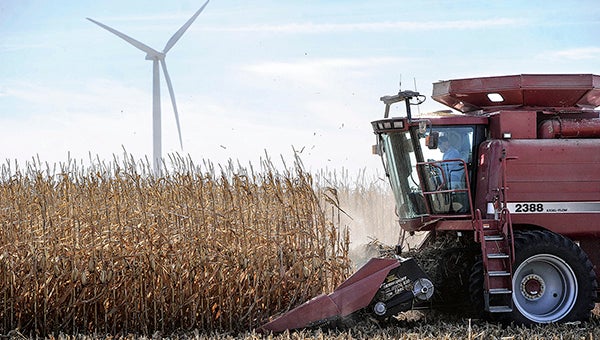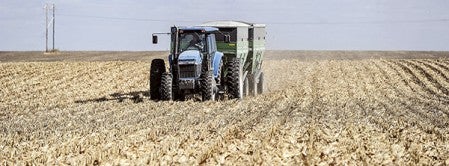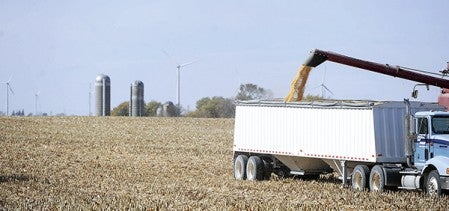Farmers on the move: Prime October conditions have farmers nearing harvests’ end with strong yields, but prices are lagging
Published 7:01 am Sunday, October 25, 2015

A combine moves through a field, harvesting corn on a field belonging to Dan Gehling southwest of Grand Meadow. Eric Johnson/photodesk@austindailyherald.com
Though sporadic rain fell across the area Friday, Jack Bergstrom didn’t think it’d be enough to keep him out of the fields. But it wouldn’t have been an unwelcome break.
Farmers in Mower County and across the state have seen an October with just about perfect weather conditions that are helping many farmers near the end of their harvests early.
Bergstrom noted some years it’s nice to see some rain during harvest for a quick break to take a breather or fit in some repairs. That hasn’t been the case this year.
“This year it’s been go, go,” he said
Already on Oct. 23, Grand Meadow farmer Dan Gehling was nearing the end of his harvest with one of the best corn crops he’s seen, while his son, Michael Gehling, was seeing many farmers in a similar position through his role as YieldPoint specialist for CHS in Grand Meadow.
“We’ve had quite a month of October to be working here,” Michael said. “We haven’t had much of a break.”
“No break,” Dan added. “Everybody’s just about dead.”

Dan Gehling drives across the field to pick up another load of corn from a field southwest of Grand Meadow. Eric Johnson/photodesk@austindailyherald.com
Many area farmers like Dan said they’re seeing one of their best years ever in terms of corn yields. According to the USDA’s October crop production report, Minnesota will be harvesting 1.43 billion bushels of corn this year from 7.75 million acres of fields.
“I mean it’s been a good year, for corn particularly,” Dan said.
Grand Meadow farmer Marlin Fay agreed.
“Probably one of the best crops we’ve had here in my time of farming,” he said.
Overall, farmers have been pleased with this year’s growing season, and October’s great weather — along with an early planting — has put many farmers a week or more ahead of the last few years’ harvests.
“Nice low humidity days and no rain now; it’s perfect,” Dan said.

Dan Gehling talks about the state of his crops in one of his fields Tuesday afternoon southwest of Grand Meadow. Eric Johnson/photodesk@austindailyherald.com
At times, Fay said this growing season was on the verge of being too wet, and he noted the summer could have used a bit more heat. But overall, things were good. He didn’t have to look too far to see a sign that the season closed on a strong note. Frequently, conditions dry out in August, which causes lawns to turn brown, but that didn’t happen this year.
“It’s just about perfect as far as a growing season,” he said.
Minnesota is also expecting a record soybean crop of 364 million bushels. Farmers in southeast Minnesota have been seeing 50 to 60 bushels per acre with some reporting 70 bushels per acre, according to Minnesota, Extension educator Lisa Behnken. Normal yields are typically between 40 to 50.
In good spots, farmers like Fay and Dan have averaged yields of 60 bushels per acre or more for beans. But it hasn’t been perfect everywhere. Dan planted his soybean crop early and suffered some white mold. Much of that, he said, is due to time related to July rains during the pods’ development. That’s hurt his soybean yields, while others could be looking at their best bean crops in many years too.
“I got unlucky,” he said.
In one field, for example, Dan’s soybeans neared 70 bushels an acre in one spot and 30 bushels per acre in others due to white mold damage.

Farmers are reporting good crops throughout the area, both corn and soybeans. Eric Johnson/photodesk@austindailyherald.com
Fay noted yields are progressively getting better thanks to modified crop varieties which are more resistant to drought and other issues, but overall yields were just better this year.
“Overall, it’s been a really, really good year for crops,” he said.
Fay has averaged 60 bushels an acre for soybeans and more than 200 an acre for corn, but he also saw white mold in one field, which dropped his yields to 52 bushels per acre.
Bergstrom broke 200 bushels an acre, which he noted was good for his sandy soil. He noted many farmers could be averaging 225 or better in areas with better soil.
The good yields will be tempered somewhat by low commodity prices. Prices for corn and beans have been the lowest in the past five years, according to USDA National Agriculture Statistics Service data.
“It ain’t good,” Dan said of the prices. “That’s the tough part.”
Minnesota’s corn price in August was $3.46, the most recent month the USDA has data, and farmers haven’t seen it increase much past the $3.50 mark. Those prices this year are half of what they were in August of 2012. Soybean prices are also down, with August prices around $9.60.
The low prices didn’t come as a surprise to Bergstrom, who noted prices are commonly drive by supply and demand. With good yields, the prices drop.
“Of course, we’d all like to see it go back up there,” he said of past higher prices.
Bergstrom, like other farmer, will try to store some grain in bins on the farm to wait out the market
“Hopefully the market goes up and well haul to town then,” he said.
—The Associated Press contributed to this story.



